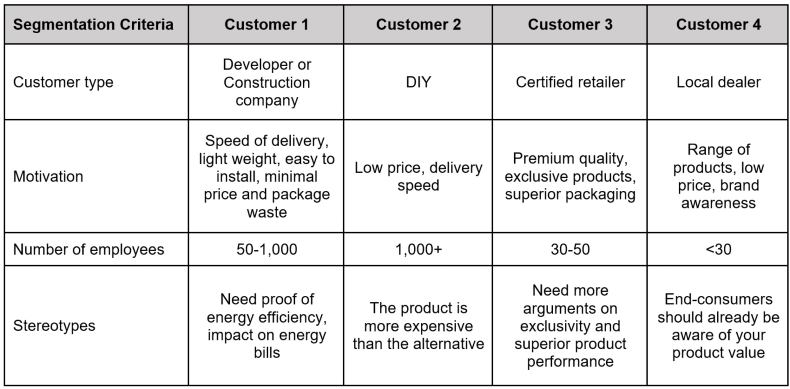Target audiences are strategically identified groups of customers who are interested in a particular product or service. They are the foundation on which every business is based.
Research and experience show us that "blanket" advertising or marketing doesn't work: You can't sell everything to everyone. Without dividing your potential buyers into segmented groups, there is no sales growth.
In today's competitive landscape, many B2B companies are reviewing their strategies, and that often includes a more careful segmentation of target audiences—both to sell more accurately and to budget more efficiently for marketing.
Therefore, it's important to understand segmentation in more detail and learn how to best carry it out to ensure increased sales.
Mistakes That Lose Sales
Offering goods or services to those who don't need them is a waste of resources. If you use a broad audience, you're going by the "if you're lucky" method.
For example, everyone needs windows, but for B2B marketers that original broad target group ("everyone") can be divided into architects/designers, builders, DIY stores, distributors, and developers. One window could be used for resale, the other for noise insulation and energy saving, the third for interior decoration, and so on.
The value of the same product is different for each segment of your audience. A broad audience must be broken down into narrower groups for ads and messaging to work.
Personalized Communication Supposes Segmentation
Once a customer makes a decision to buy, the task of the marketer is to build personal communication with the potential client. The company that knows the client better... wins.
Sales representatives should be able to assign their clients to one of the defined segments by their basic attributes while avoiding the possibility of having one client falling into several segments simultaneously.
By segmenting, marketers can develop ads that consider the problems, needs, and expectations of each group. They can create proposals with a suitable product mix to meet the needs of a particular segment. And they can use special events, promotions, bonuses, and discounts based on the behavioral and emotional characteristics of your target audience.
The key value of segmentation is this: Representatives of a core target audience are more likely to buy your product or service. If you attempt to reach a wide audience, you spend all your time guessing what a person wants when you could be selling to them.
Parameters for Target-Audience Segmentation
When dividing a business audience into segments, you must take into account the region where the business is represented; its capabilities, service-level expectations, and product requirements; its motivation; and, of course, its decision makers.
Here are examples of possible segmentation criteria; using them could well help you to build scores of segments:
- Industry: niche and place in the market (raw materials, manufacturing, construction, retail, distribution, design, etc.)
- Geography: location and network size (local player, federal network, global, etc.)
- Price policy: low budget, high end/premium, or a mix of the two
- Product performance: product mix and services required to execute
- Business size: number of ongoing projects, sales volume, annual revenue
- Personnel qualification: expertise, experience
- Capabilities: methods of production/processing, automation systems, etc.
- Behavioral parameters: level of urgency and volume of purchase
- Buyer profile: supplier loyalty, risk assessment
- Procurement steps: selection criteria, motivation to purchase
- Purchasing committee: key decision makers
- Beliefs: stereotypes, doubts, objections
- History with company: new, current, or returning customer
- Cooperation with competitors
Much of that information can be found in public documents and online searches, whereas some stats are more subjective and rely on focus groups.
Unlike the consumer market, segmentation of corporate target audiences is carried out less often—once every 2-3 years, which is usually enough to make adjustments based on demand changes.
Five Steps to Target-Audience Segmentation
1. Identify all possible criteria
Write down all the parameters that theoretically can be applied to your target audience (use some of the ideas in the above list).
2. Perform customer analysis
Break the audience into groups:
- Loyal: satisfied with the level of cooperation
- Complicated: intermittent or only periodic demand
- Potential: currently working with competitors
- Impossible: will never buy
3. Compare the data
Make a table for each client group and segmentation criterion. Below is a possible example for a segmentation of loyal customers at a company producing windows.

4. Highlight the target audience segments
Select various criteria by which your target groups differ. Find options that affect or disclaim the purchase decision.
Here are some example target audience segments from the table above:
- Certified retailers with up to 50 employees. Product quality and service levels are more important than the price.
- Construction companies with a staff of more than 1000 people. Fast and cheap deliveries are important, which is similar to DIY stores, but this customer is interacting with the end-consumer at a different sales cycle, which means different discussion points at the point of sale.
- Window dealers with fewer than 30 employees. Price is important, the dealers are well known at a local level, and they have limited resources for marketing, training, and retaining their sales staff.
As you can see, at least three target audience segments have been identified in just one industry. It is important to consider the smallest details, as something that attracts one client can push another away.
5. Choose a marketing strategy
Determine the specifics of your advertising campaigns: methods of influencing the audience, capturing and retaining customers, and handling objections based on the needs of target audience groups.
* * *
Filtering your audience helps you to reach your goals more quickly. It protects your company's resources by sifting out nontargeted customers before starting the marketing process. Why try to sell to an audience that is misled by advertising and ends up buying nothing?
"Carpet-bombing" your audience is an out-of-date strategy. Today, companies should focus on specific segments, in the process building their reputation and engendering long-term cooperation.




